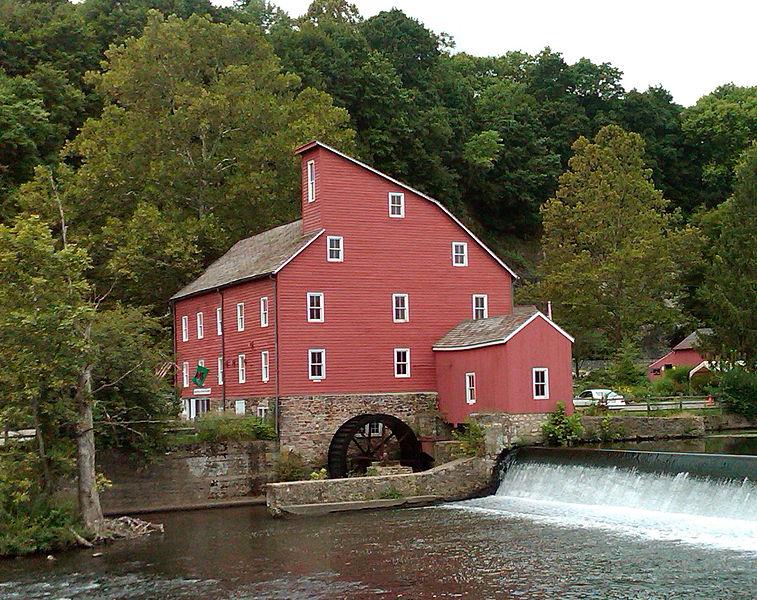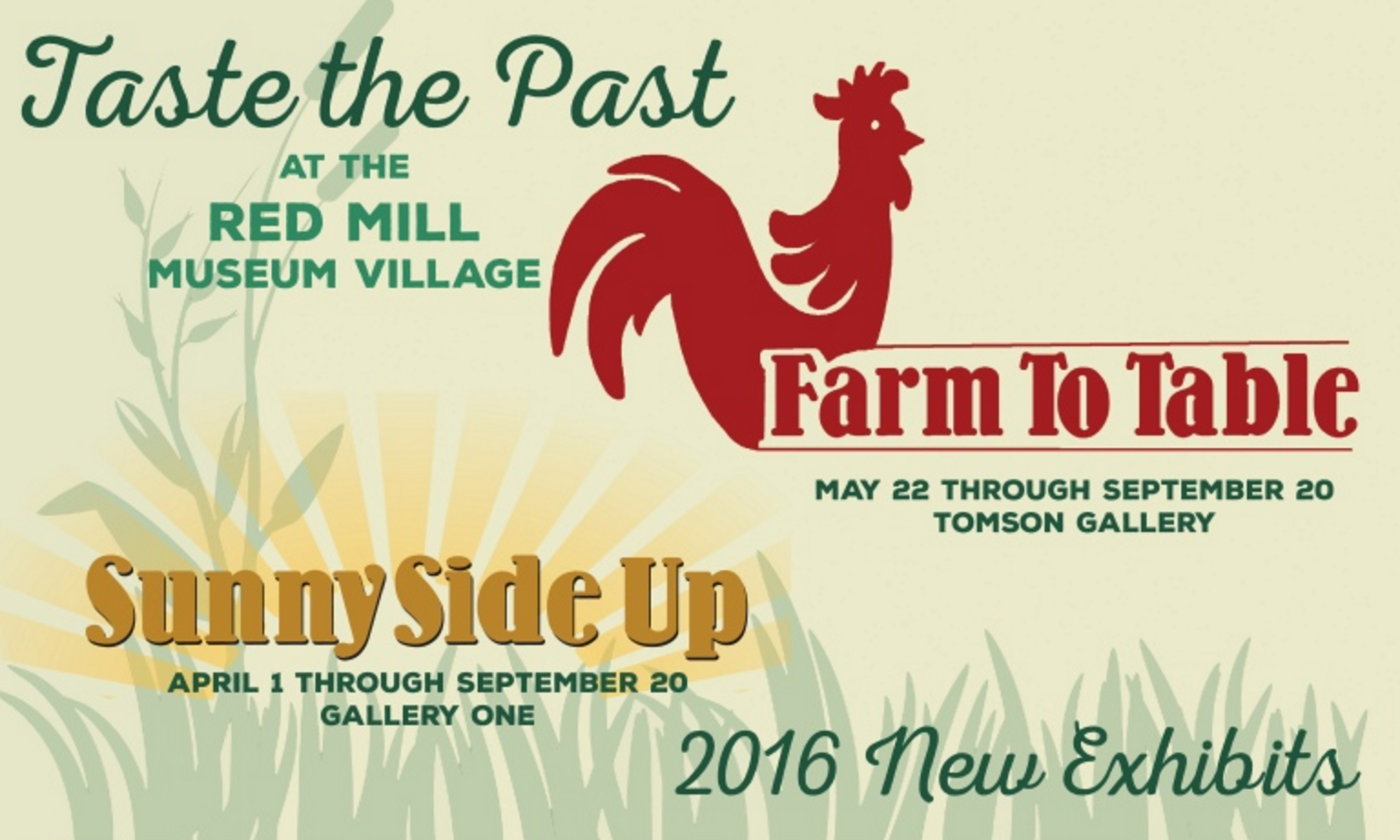Grantee Spotlight is a recurring feature that helps us to share a more in-depth look at the great work our grant recipients are doing here in Central New Jersey. Keep checking back for new Spotlight pieces! (view previous features here and here).

The Red Mill, a fixture of Hunterdon County and a historic landmark of both local and national significance, is the striking backdrop to Clinton’s Main Street and the focal point of countless tourist photographs. But the mill is just one of twelve historic buildings that make up The Red Mill Museum Village, in operation since the early 1960s.
Elizabeth Cole, the museum’s Curator of Collections, is incredibly passionate about the mill. But she is also quick to point out that it’s only one part of a museum that offers a rich look into local and national history by way of its unique buildings, collections, and community.
Over the past seven years we’ve awarded a number of grants to the Red Mill Museum Village, and throughout that time we have also been lucky to work with Elizabeth, whose enthusiasm for the museum’s mission is obvious to anyone who meets her.
Our Consulting Administrator, Molly Harper, recently had the chance to speak with Elizabeth about her work, her love for local history, the most common misconceptions about the Red Mill, and the museum’s two new 2016 exhibits.
Molly: You are the longest tenured member of the museum’s staff. Tell me a little bit about your path to working here and about what it was like when you started [in 2005].
Elizabeth: Before I came to the Mill, I was Assistant Director of the Montclair Historical Society. At the time, there was a young director there who was a great mentor to me. I learned a lot from her and because of that experience felt like I could really do more.
So when I started at the Mill in 2005, I was excited to take on more responsibilities and do a lot more. I actually started out as Curator of Education, so I was doing tours and working with groups of kids. I really loved making those connections and working with the children.
But I was also a young person joining a staff of individuals who had all been there a long time. I had a lot to learn from an experienced staff, but I was also looking to “rock the boat” a little, so to speak. At the time, the museum only had one or two computers. We were still making brochures by cutting and pasting pieces of paper! I was really hoping to help modernize the museum. I was also hoping to help cultivate a welcoming atmosphere that would be warm and inviting for visitors.
Molly: How have things changed since that point?
Elizabeth: Since I have been here, the atmosphere has really changed and become more welcoming. I have also seen a lot of change in staff. Our current staff is great – we work really well together and it is a very collaborative, warm environment.
In recent years, the museum as a whole has really taken on the charge of becoming even more professional. We have been focused more on assessment and evaluation of our programs and exhibits and working towards StEPs accreditation.
In 2010, I became Curator of Collections. This presented me with several new challenges. For one, it was very different from my previous role, which had been focused on tours and educational programming. For another, I was assuming the responsibility of updating the organization of the collection, which is a big undertaking. This role has been a challenging one, but a great one.
Molly: What does your job entail? What does it really mean to be Curator of Collections?
Elizabeth: As Curator of Collections, I am responsible for using our collection in a way that excites people. This is usually through the creation of rotating and long-term exhibits.
But there are parts of the job that people don’t often think about – the “dirty work”. This includes cataloging, housecleaning, properly caring for everything we have, the legal end of things. Perhaps the right curatorial terminology for this is “collections management”. For me, I think of it as “caring”.
There is a big ethical piece to the responsibility of managing the museum’s collection. These objects and artifacts are in the public’s trust. I feel a great sense of responsibility to take care of those things, take care of them well, and ensure that they’re accessible to the community.
Molly: Can you give me an idea of the size and scope of the collection?
Elizabeth: This doesn’t include everything, but we have about 3,000 photographs, 3,000 textiles, and 8,000 woodworking tools. Most of what we have are industrial and agricultural artifacts.
Our collection is extremely unique. This is partly because it includes some of the artifacts given to the museum by [its founders], The Red Mill Five. For example, we have beautiful antique lamps given to us by founder James Marsh. They reflect not only the history of this local person but also what was valuable during his time. One of those lamps was featured in our 50th anniversary exhibit, 50 Years 50 Favorites.
Something many people don’t realize is that our collection includes all twelve of our historic buildings. A lot of times, people will come and say they don’t want to go to the museum – they “just want to walk around”. What they don’t realize is that our whole site is the museum.
Molly: Many people think “museum” and think of a building with exhibits inside of it.
Elizabeth: Exactly. But here, “walking around” the property is actually going to the museum. There is so much history in walking the site and experiencing the quarry, the tenant house. And the experience is so accessible to the local community. I think it makes us one of the most unique sites in the country.
Molly: I can tell how much you care about the Mill’s history just from listening to you.
Elizabeth: I have always had a love for history. I think my parents really instilled that in me. When I was growing up, they were always taking me to museums, historic sites. My dad was very interested in structures and buildings – in how things were made. Anywhere we went he would be inspecting the joints of the historic buildings. My mom, on the other hand, was very interested in examining the stories of the places we went to. She asked a lot of questions like “What was it really like to live in this place?” She was always questioning, questioning. I really learned to appreciate history from them.
I still visit historic places with my parents. To this day they are my favorite people to do that with.
Molly: You’ve shared what you think sets the museum apart from other museums. What sets it apart as a workplace?
Elizabeth: I love what I do as Curator of Collections, and I love local history. But what I really love about this work is the people at the museum. The people at the museum are what I really care about.
Something that really sets us apart is our volunteer base. Our current volunteers are so helpful and invested, and during my time here, we have had some that have been working with us for over twenty, thirty years. Their help is so important, not just for day-to-day operations but for special projects as well. One of them, Richard Pierce, has been such a huge help to me in putting together exhibits and managing the collection. He has become a great friend.
While our volunteer base is strong, it is primarily the older generations who work with us. This is a good thing, because they share a huge bank of knowledge about the local community and its history. But we are also looking for ways to engage with and encourage interest from the younger generations in our community. How do we get them involved in local history?
Our assistant director, Tim Betz, has been putting together some great programs to try to encourage younger community members to get to the museum.
Molly: Tell me a little bit about your two new exhibits for 2016.
Elizabeth: We have two related exhibits this year focusing on food production at the turn of the twentieth century.
The first, Sunny Side Up, has been open since April 1. It looks at the tradition of breakfast at the turn of the century. The exhibit was inspired in part by a quote from one of the Mulligans describing a typical spread of Sunday breakfast. It has local inspiration, but it is really about the cooking gadgets and processes that facilitated the rise of breakfast as a larger cultural tradition.
Farm to Table opened on May 22 in the Tomson Gallery. This exhibit is really about the “to” in “Farm to Table”; it focuses on how you got your food and the journey from farmers’ fields to individual homes.
Molly: What is one thing you want the community to know about these exhibits, and about the museum in general?
Elizabeth: Many of our exhibits – including these two current ones – speak to national, cultural themes. They reflect what life was like in Clinton at different times, of course. But they also show the connections between what was happening here and what was happening in the rest of the state and the country.
For the museum, I want people to know that we are not just a pretty building to look at. We are a museum – a museum village. Coming here is not just about observing one building. It’s about understanding the scope of what we have to offer as a museum.
Molly: It’s more than just a landmark of the area.
Elizabeth: It has investment from enthusiastic volunteers and a unique history and so much to offer as a museum. It is truly a local treasure.
Farm to Table & Sunny Side Up will be open through September 20, 2016.
For hours, admission, and more information, visit the Red Mill’s website
The Red Mill Museum Village on Facebook




